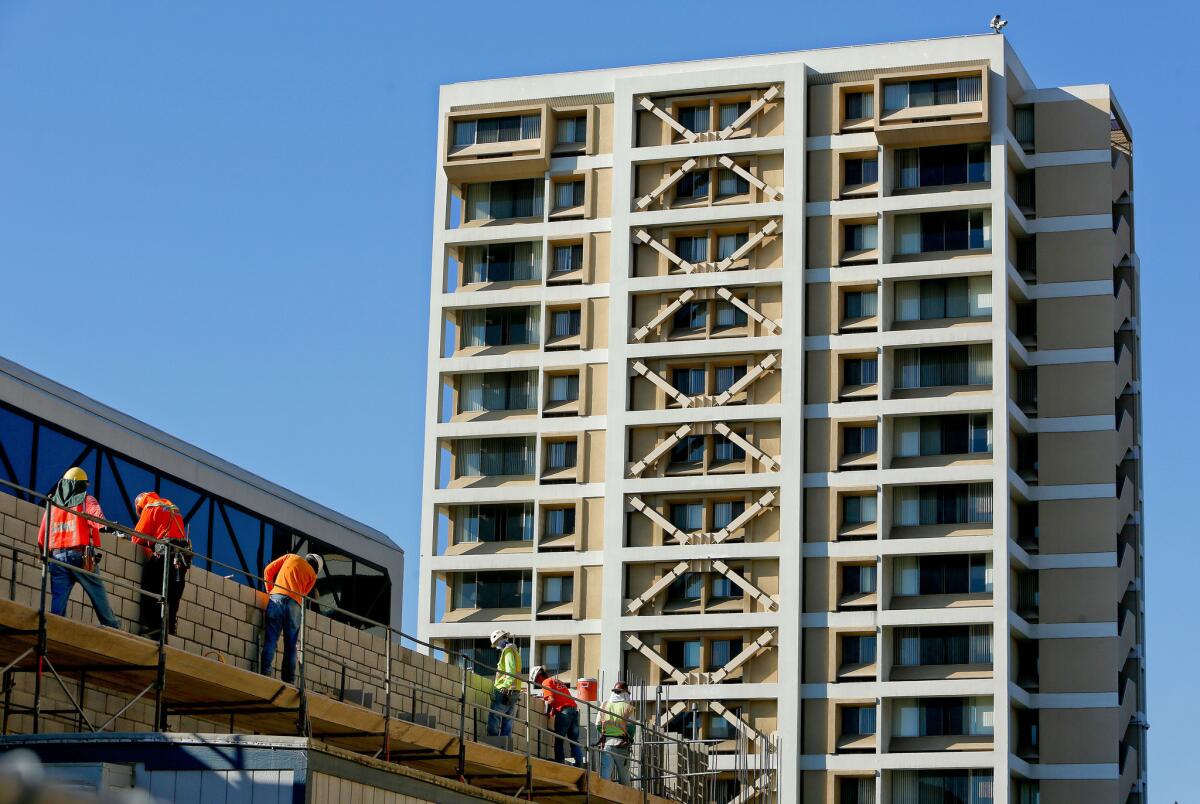Statewide tax credits for seismic retrofitting face a hurdle on Gov. Brown’s desk

Thousands of buildings across Los Angeles may be at risk of collapsing in a big earthquake, and the mayor is pushing for more of them to be seismically retrofitted, as USC’s Webb Tower was with x-beams, seen in 2013.
After decades of false starts and stumbling progress, California cities’ efforts to strengthen buildings that could collapse in a massive earthquake may take a leap forward in coming weeks, as Gov. Jerry Brown considers legislation offering generous subsidies to property owners for seismic retrofitting.
The bill, which would use tax credits to offset 30% of the cost of improvements to vulnerable buildings, will reach Brown’s desk at a critical moment. City officials in San Francisco and Los Angeles have made the retrofitting of shaky buildings a priority. In L.A., Mayor Eric Garcetti has proposed what would be the most expansive citywide retrofitting requirement in the state’s history.
But after passing out of the state Senate on a 37-1 vote this month following unanimous approval by the Assembly, the bill still has another, potentially severe, challenge to overcome: the scrutiny of a governor whose fiscal instincts have repeatedly foiled the best intentions of legislators, including those in his own party.
Brown often speaks of himself as a steward for California, and has not hesitated to throw money and political capital behind projects — such as the high-speed rail line — that he deems integral to the state’s future.
At the same time, he has repeatedly shown a hawkish streak when it comes to state finances. And some observers in the state capital say he has been particularly skeptical of tax credits, viewing them in general as poor fiscal policy.
“Legislators like to use the tax structure to do things, and this governor hasn’t on the whole been all that interested,” said Fred Silva, a senior policy advisor at the think tank California Forward. “He’s a steward of the state’s fiscal structure, and he has been from the beginning.”
Brown spokeswoman Deborah Hoffman declined to comment on the retrofitting bill, AB 428. The governor has until Oct. 11 to take action on the measure — by signing or vetoing it, or letting it become law without his signature.
Proposed by Assemblyman Adrin Nazarian, a Sherman Oaks Democrat, the bill has gone largely unnoticed in a legislative session consumed by debate over topics such as drones, climate change, vaccine regulations and aid-in-dying treatment.
But earthquake safety advocates say the legislation would be a milestone in what has long been an intractable area of public policy. While not a panacea, they say, Nazarian’s bill is a big step toward addressing the Achilles heel of retrofitting proposals: property owners’ reluctance to open their wallets.
“These are giant steps forward in that fight that’s been going on for decades now about retrofits,” said former L.A. City Councilman Greig Smith, who tried unsuccessfully to advance retrofitting regulations before leaving office in 2011. Previous efforts, he said, have all gotten hung up on the financing question.
“We get into that back-and-forth fight over whose responsibility is what,” Smith said. “And that’s where it always bogs down.”
Should Brown choose to veto the seismic tax credit, it would be a blow for Garcetti, whose proposed retrofitting mandate might not win the L.A. City Council’s approval without a means of softening its financial impact. In January of last year, Councilman Mitchell Englander, who supports Garcetti’s plan, said it would be “political suicide” to require retrofits without offering financial assistance to building owners.
In a statement, Garcetti said the proposed tax credit was a “much-needed tool … rewarding building owners willing to complete life saving seismic retrofits with some financial relief.”
Officials have known about the dangers of quake-vulnerable buildings for decades, but concerns about costs thwarted earlier efforts in L.A. to identify and require property owners to retrofit their buildings.
More than 1,000 concrete buildings, as well as wooden structures with weak first floors, across the city may be at risk of collapsing in a big earthquake. Sixteen people were killed when one such building pancaked in the 1994 Northridge earthquake. City officials say there are at least 12,000 of these “soft-story” structures in L.A.
This year, Garcetti joined the mayors of San Francisco, Oakland, Berkeley and Santa Monica in signing a letter of support for AB 428 addressed to the chairman of the Senate budget committee.
Others, while supportive of the bill, say it is imperfect. David Cocke, president of the structural engineering firm Structural Focus and a spokesman for the Structural Engineers Assn. of Southern California, said the bill “certainly is a positive step forward, and it’s better than nothing.” But he said it has notable shortcomings.
He pointed out that AB 428 could create inconsistent standards of earthquake safety across the state, since it would allow individual cities to determine which buildings — from mobile homes to office buildings — qualify for the tax credits. And he said the bill’s annual funding cap of $12 million would be insufficient to retrofit large concrete buildings, which can cost more than $1 million each to strengthen, on a wide scale.
The tax credit also would not go into effect until 2017, which could delay retrofitting efforts, Cocke said.
Assemblyman Mike Gatto, a Glendale Democrat, voted for the bill this year after chairing the committee where an earlier version of the bill died last year. He said that while he admired Nazarian’s goals, retrofitting subsidies are a tough sell for Californians who see them as giving money to the coastal cities that have more aggressively pursued earthquake preparation than smaller cities.
Water and Power is The Times’ guide to the drought. Sign up to get the free newsletter >>
“The seismic retrofitting, for better or for worse, is largely an issue that people see as a San Francisco and Los Angeles issue,” Gatto said. “Obviously, this does nothing for Joshua Tree. This does very little for San Diego and Fresno.”
Lenny Goldberg of the California Tax Reform Assn., which opposes AB 428, said that the bill, which would offer tax credits on a first-come, first-served basis, isn’t a rational approach to funding retrofits.
“We don’t know whether we’re dealing with those who are most in need or those who have sharp tax lawyers,” Goldberg said.
Nazarian said he knows the bill has shortcomings, but that it is intended as a “foot in the door” that could lead to more comprehensive policies. But he said that even an “imperfect” law could save lives and property in the event of a devastating earthquake, and that the state has an unusual window for action because of its budget surplus.
“I’m hoping that those points all are weighed by the governor,” Nazarian said, “given that we’re at a time when we can be making these investments.”
ALSO
The heat and the lines couldn’t keep them from the Broad on opening day
California GOP softens its message on immigration in a bid for survival
In Glendale, drought is cast in stone
More to Read
Sign up for Essential California
The most important California stories and recommendations in your inbox every morning.
You may occasionally receive promotional content from the Los Angeles Times.











